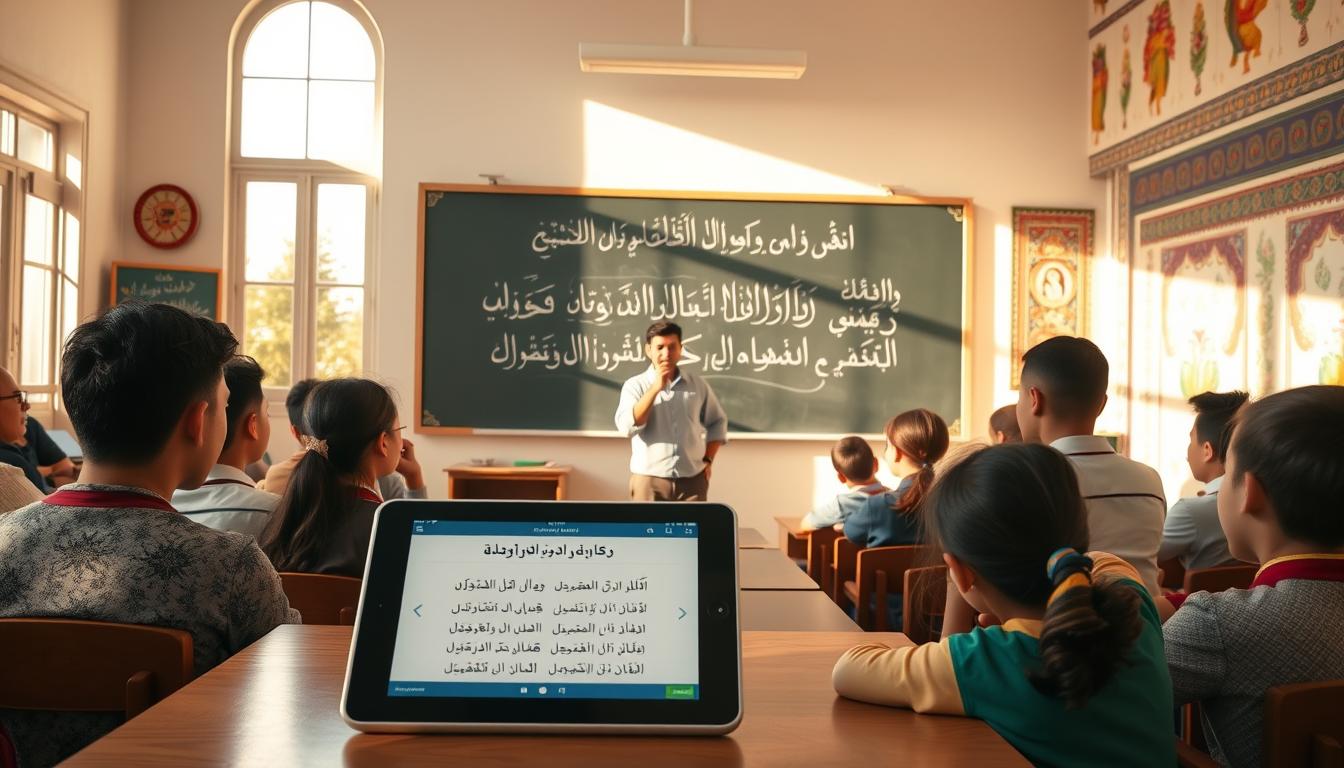Learning Arabic grammar is key for good communication in Arabic. Our guide makes it easy to learn. At Kalimah Center, we’ve taught Arabic to many for over 10 years. Our courses are for beginners and those who know a bit more.
We want learning Arabic to be fun and rewarding. Our lessons are interactive and engaging. This makes learning Arabic grammar enjoyable.
Kalimah Center makes learning Arabic grammar affordable and accessible. Our group classes are much cheaper than private lessons. This is great for those who want to learn without spending a lot. Start your Arabic journey by checking out our arabic language courses.
Introduction to Arabic Grammar
Our lessons help you get better at speaking and writing Arabic. We focus on using what you learn and avoiding mistakes. Thousands of students have become fluent and confident in Arabic with our help.
Table of Contents
Introduction to Arabic Grammar
Arabic grammar is key to the Arabic language. It’s vital for clear communication. Online Arabic lessons offer a deep dive into Arabic grammar. They cover nouns, verbs, and sentence structure.
Arabic grammar breaks down into two parts: morphology and syntax. Morphology looks at word structure. Syntax is about sentence formation. Knowing these rules is essential for speaking, reading, and writing Arabic well.
Importance of Learning Arabic Grammar
Learning Arabic grammar is very important. It helps you grasp the language’s structure and how to communicate well. With online Arabic lessons, you get lots of resources to learn grammar.
Overview of Arabic Sentence Structure
Arabic sentences follow a subject-verb-object order. But, the language also allows for flexibility. Particles and pronouns are key.
Understanding sentence structure is key for clear communication. By studying grammar and practicing with online Arabic lessons, you’ll get better at Arabic.
The Arabic Alphabet and Sounds
Learning the Arabic alphabet is key for basic arabic grammar. It has 28 letters, all consonants. Each letter changes form based on its word position: Initial, Medial, Final, and Isolated. Knowing these forms is vital for reading and writing Arabic.
To get better at pronunciation, try arabic grammar exercises like listening to letter sounds and saying them out loud every day. Flashcards help many students remember the Arabic alphabet. Arabic calligraphy is seen as both an art and a cultural base in Islamic Arab culture.
- The Arabic alphabet has 18 symbols that make 28 sounds.
- Phonetic sounds are the smallest speech units in a language.
- Arabic is read and written from right to left, with no upper or lower case.
By learning the Arabic alphabet and practicing basic arabic grammar, you can get better at reading and writing. This helps you communicate more clearly in Arabic.
Nouns and Gender in Arabic
Learning about nouns and gender in Arabic is key for beginners. Arabic has two main genders: masculine and feminine. The gender of a noun changes how other parts of the sentence work, like adjectives and pronouns.
Arabic nouns can be singular, dual, or plural. The feminine marker “ة” (ta’ marbuta) shows if a noun is feminine. It’s often found at the end of words.
- شجرة (shajarah) – “tree”
- مدرسة (madrasah) – “school”
These examples show how the feminine marker works. To get better at Arabic, you need to understand these basics well.
Talking with native speakers and using online resources can help a lot. Doing exercises and real-life practice makes you better. Remember, every word in Arabic has a gender, making the language very consistent.
Verbs and Tenses in Arabic
Learning Arabic means getting to know verbs and tenses well. Arabic verbs use a root system of three consonants. There are six main forms of Arabic verbs. To learn, you need to understand how to change verbs to show tense.
Online Arabic lessons teach verb conjugation. This helps learners use verbs right in sentences. The past tense adds specific suffixes to the root. The present tense uses prefixes and sometimes suffixes. The future tense starts with “سـ” (sa-) or “سوف” (sawfa).
For those learning online, practice is key. Use apps like Duolingo and Memrise to help. With regular practice, you can get better at Arabic verbs and tenses in a few months. Learning Arabic can be tough, but with the right approach, it’s doable. For more tips on learning languages, check out this resource.
- Arabic verbs are based on a root system, typically consisting of three consonants.
- The past tense is used to describe completed actions.
- The present tense is used for actions happening now, habitual actions, and can also indicate future intentions.
- Regular practice is essential for mastering Arabic verbs and tenses.
By following these tips and practicing often, learners can get better at Arabic verbs and tenses. This will help them improve their Arabic skills through online lessons and courses.
The Role of Articles in Arabic
Learning about articles in Arabic is key to getting good at arabic grammar rules. The definite article “ال” (al) works like “the” in English. It makes indefinite nouns definite. For instance, “كتاب” (kitaab) is “book,” but “الكتاب” (al-kitaab) is “the book.”
When doing arabic grammar exercises, knowing the difference between definite and indefinite articles is vital. Arabic doesn’t have an indefinite article. If “ال” (al) is not there, the noun is indefinite. The definite article sounds different before certain letters but not others.
Students often get confused by using “ال” (al) wrong. This can mix up “الكتاب” (al-kitaab) for “the book” with “بيت” (bayt) for “home.” It’s important to practice a lot. Reading Arabic texts like books and newspapers helps learners see how grammar works in real life.
Understanding articles in Arabic and doing arabic grammar exercises helps learners get better. Remember, learning Arabic grammar takes time and effort. But with the right tools and hard work, anyone can get good at it.
Adjectives and Adverb Usage
Learning basic arabic grammar means understanding adjectives and adverbs. In Arabic, adjectives must match the nouns they describe in gender, number, and case. For example, “big” changes form for male and female nouns. Adverbs, which describe verbs, adjectives, or other adverbs, show manner, time, place, or degree.
For beginners, adverbs are split into two types: Time and Place. “صباحًا” (ṣabāḥan – in the morning) and “مساءً” (masāʾan – in the evening) are examples of Time adverbs. “أمام” (ʾamāma – in front of) and “فوق” (fawqa – above) are Place adverbs. Knowing these is key for clear Arabic communication.

Here are some important points about adjectives and adverbs in Arabic:
- Adjectives must agree with nouns in gender, number, and case
- Adverbs modify verbs, adjectives, or other adverbs
- Adverbs of Time and Place are two main types of adverbs in Arabic
- Understanding adjective and adverb usage is essential for basic arabic grammar and arabic grammar for beginners
Mastering adjectives and adverbs boosts Arabic skills and communication. With effort, anyone can grasp arabic grammar for beginners and tackle more complex topics.
Prepositions in Arabic
Learning intermediate arabic grammar means mastering prepositions. In Arabic, these words show where, when, and how things happen. There are about 21 prepositions, divided into two types: detached and attached.
Common prepositions include في (fi) for “in”, من (min) for “from”, and إلى (ila) for “to”. They link words to show time, place, direction, and how things happen. For instance, في (fi) is used for time, like في الصباح (fī al-ṣabāḥ) for “in the morning”.
In arabic language courses, learning prepositions is key. They are split into three groups: true, redundant, and quasi-redundant prepositions. Always, prepositions come before the noun or pronoun they connect to.
Here are some common Arabic prepositions and their meanings:
- في (fi): In
- على (ala): On
- إلى (ila): To
- من (min): From
- عن (an): About
Mastering prepositions boosts your grasp of Arabic. It helps you communicate better. With effort, you’ll get good at using them to make clear sentences.
Practice and Application of Lessons
Mastering arabic grammar lessons needs regular practice. Online arabic lessons help learners understand the language better. It’s best to practice for 15 minutes a day, focusing on common words used in daily life.
Games and apps make learning fun and keep you motivated. Watching movies, listening to music, and podcasts in Arabic also helps a lot. Being part of a language group boosts your motivation and learning.
Here are some ways to practice arabic grammar lessons:
- Talking with native speakers or language exchange partners
- Watching Arabic movies or TV shows with English subtitles
- Listening to Arabic music and podcasts
- Reading Arabic texts, like news or books
By using these methods, learners can get better at arabic grammar. Online arabic lessons offer a detailed guide on how to practice. This way, learners can use their skills in real-life situations.

Resources for Further Learning
Exploring Arabic grammar has just scratched the surface. There are many resources to help you learn more and get better. You can find books, online courses, websites, and language apps to keep learning.
Online platforms like Duolingo, Babbel, and Rosetta Stone are great for learning Arabic. They offer lessons on basic and complex grammar. Sites like Arab Academy and Madinah Arabic have courses with videos, quizzes, and assignments for all levels.
For a fun way to learn, try Memrise, Anki, and Lingualism. They use flashcards and quizzes to help you remember words. Listening to Arabic podcasts and speaking with native speakers can also improve your skills and understanding of the culture.
FAQ
What is the importance of learning Arabic grammar?
What are the basic components of Arabic grammar covered in this guide?
How can the lessons help beginners and intermediate learners improve their Arabic skills?
What resources are available for further learning and practice?
How can learners apply the Arabic grammar lessons in real-life situations?
Source Links
- Online Arabic Grammar Course – KALIMAH – https://kalimah-center.com/online-arabic-grammar-course/
- Online Arabic Grammar Course – E-Hoopoe – https://e-hoopoe.com/course/arabic-grammars-course-an-nahw/
- Comprehensive Intro to Arabic Grammar – ArabiKey – https://arabikey.com/arabic-grammar-introduction/
- Master the Basics of Arabic Grammar – https://nashraharabic.com/master-the-basics-of-arabic-grammar/
- What Are the Basics of the Arabic Alphabet – Arab Academy – https://www.arabacademy.com/what-are-the-basics-of-the-arabic-alphabet/
- Arabic Alphabet | Arab Academy – https://www.arabacademy.com/arabic-alphabet/
- A Comprehensive Guide to Arabic noun and pronoun rules – https://nashraharabic.com/a-comprehensive-guide-to-arabic-noun-and-pronoun-rules/
- Gender In Arabic: Nouns, Pronouns, Verbs, And Adjectives – KALIMAH – https://kalimah-center.com/gender-in-arabic/
- Understanding Arabic Verbs and Tenses – https://nashraharabic.com/understanding-arabic-verbs-and-tenses/
- Arabic Tenses Full Guide With Charts, Exercises And Worksheets – KALIMAH – https://kalimah-center.com/arabic-tenses/
- Arabic Grammar Rules: A Beginner’s Guide to Mastering the Basics – https://preply.com/en/blog/arabic-grammar-rules/
- The Arabic Definite Article “AI” and Its Uses – Arabic Blog – https://earabiclearning.com/blog/2024/09/the-arabic-definite-article-ai-and-its-uses/
- The Arabic Definite Article “Al” and Its Uses – Arabic Blog – https://earabiclearning.com/blog/2024/08/the-arabic-definite-article-al-and-its-uses/
- Arabic Adverbs – Zarf In Arabic Grammar And Al-Maf’ulat Al-Khamsah – KALIMAH – https://kalimah-center.com/arabic-adverbs/
- 1.4: Parts of Speech in Arabic – https://human.libretexts.org/Bookshelves/Languages/Arabic/Arabic_Level_One/01:_Chapter_Oner-_An_Overview_of_Arabic/1.04:_Parts_of_Speech_in_Arabic
- Arabic Prepositions And Their List And Functions – From Basics To Beyond – https://kalimah-center.com/arabic-prepositions/
- Prepositions in Arabic Functions and Examples – https://nashraharabic.com/prepositions-in-arabic-functions-and-examples/
- Arabic Grammar For Beginners – MinArabic – https://minarabic.com/arabic-grammar/
- Best Arabic Grammar course Online 2025 | Quranic Institute – https://quranicinstitute.net/classical-arabic-fusha-full-track/
- Top Online Resources For Learning Arabic In 2024 | Quran Ayat – https://quranayat.com/top-online-resources-for-learning-arabic/
- Top 10 Resources for Learning Arabic Online: The Ultimate Guide – https://arabiclearning.in/blog/best-resources-for-learning-arabic.html
- A no-nonsense detailed guide to self-learning Arabic – https://medium.com/@raihanmk/a-no-nonsense-detailed-guide-to-self-learning-arabic-b0c2a1e96025

